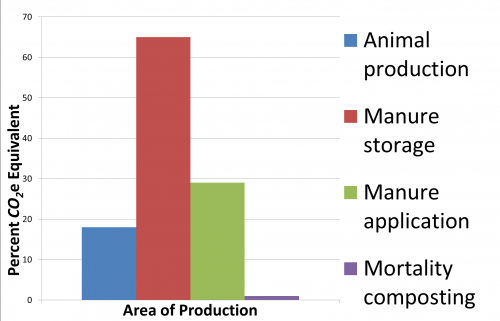Odors, air emissions and livestock mortality composting
Composting livestock mortalities should not make significant contributions to air emissions or overall farm odors.
Nearly all people initially think that a dead animal, if told nothing else about the carcass, smells badly. This is because typically their experiences are limited to road kill and mice in the garage. A well managed composting system for on-farm mortality does not have to be an air quality concern!
Similar to other areas of livestock production there are air emissions from composting livestock mortality. Greenhouse gases and ammonia are all emitted from the compost site.
 Greenhouse gases
Greenhouse gases
The same greenhouse gases that are emitted from other areas of livestock production (carbon dioxide (CO2), methane (CH4) and nitrous oxide (N2O)) are emitted from composting mortality. Methane has 24 times and N2O has nearly 300 times the global warming potential of CO2 therefore their global warming potential is expressed as an equivalent to carbon dioxide (CO2e). Research has shown that mortality composting has minimal impact on the total greenhouse gas emissions from a livestock production site. The graph on the right shows the total predicted CO2e emissions from a 2,000 swine finishing facility. From this sample farm ± 1% of the total CO2e emissions are attributed to the farm’s mortality composting unit.As odors move across the landscape they are mixed, disbursed and diluted. Therefore an easy odor control practice is to maximize separation distance. When selecting a site for the compost facility or pile, locate it away from neighbors and the farm house.Select a site so visitors to the farm, or nearby neighbors, are less likely to see the compost pile. If they are unable to see the compost site the odors will be less recognizable.A properly managed mortality compost facility will generate fewer odors than a poorly managed one. Follow the guidelines provided in the Michigan Animal Tissue Compost Standard. The Compost Standard and other information is available on line at this MSU website: https://www.msu.edu/~rozeboom/catrn.html Standing and stagnant water around the compost area may be as large of an odor source as the compost pile itself. Choose a location that is well drained. Structures should be designed to collect all runoff or roofed to protect the compost pile from collecting excess precipitation.May, G.A. and D.W. Rozeboom, 2008, Sow Body Composition for Improved Estimation of Farm Phosphorous Mass Balance, Applied Engineering in Agriculture, 24(6): 767-772
Ammonia
A composting animal will release no more nitrogen than that contained in its whole body. The most a 500-pound sow could release is 15.4 pounds NH3 (May and Rozeboom, 2008). This is a small fraction of the estimated 38,000 lbs. of NH3 emitted from a 2,500 swine breeding farm using the Koelsch and Stowell (2005) Ammonia Emissions Estimator.
Although air emissions are a global, long-term concern, the greater local concern is odor associated with composting animal tissues. The following steps will help mitigate any noticeable odors from mortality compost sites.
Separation distance
As odors move across the landscape they are mixed, disbursed and diluted. Therefore an easy odor control practice is to maximize separation distance. When selecting a site for the compost facility or pile, locate it away from neighbors and the farm house.
Seclusion
Select a site so visitors to the farm, or nearby neighbors, are less likely to see the compost pile. If they are unable to see the compost site the odors will be less recognizable.
Management
A properly managed mortality compost facility will generate fewer odors than a poorly managed one. Follow the guidelines provided in the Michigan Animal Tissue Compost Standard. The Compost Standard and other information is available on line at this MSU website: https://www.msu.edu/~rozeboom/catrn.html
Bio cap
Some carbon sources such as silage and poultry litter will have their own unique odors. While these may make excellent carbon sources for composting they may also contribute to odor. Covering the compost pile with a 6 inch layer of fresh straw, sawdust or wood shavings will reduce odors coming from the site.
Standing water
Standing and stagnant water around the compost area may be as large of an odor source as the compost pile itself. Choose a location that is well drained. Structures should be designed to collect all runoff or roofed to protect the compost pile from collecting excess precipitation.
Properly sited and managed animal mortality compost facilities will have relatively low air emission rates and associated odors.
Resources and further reading
Maycher, N., 2003, Greenhouse Gas Emissions and Opportunities for Reduction From the Alberta Swine Industry, Climate Change Central, discussion paper C3-012, available: http://www.climatechangecentral.com/files/attachments/DiscussionPapers/GHG_Emission_%20Alta_Swine.pdf
Rozeboom, 2011, Air emissions of in-vessel rotating drum and open static pile composting of swine carcasses, whole and ground, US Composting Council 19th Annual Conference and Tradeshow, available: https://www.msu.edu/~rozeboom/catrn.html
Rozeboom D.W., S. Reamer, J.O. Sanders, 2007, Michigan Animal Tissue Compost Standard, available: https://www.msu.edu/~rozeboom/catrn.html



 Print
Print Email
Email


